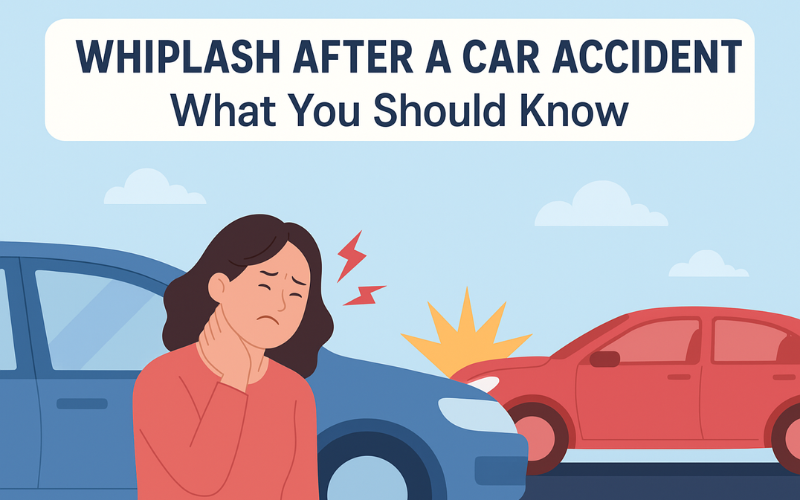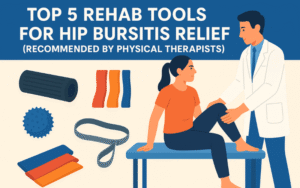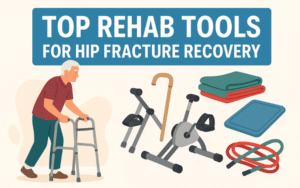Whiplash after a car accident is more common than you might think—and it doesn’t always show up right away. One moment you’re in a fender bender, and days later your neck starts to ache or feel stiff. Could it be whiplash? In this post, you’ll learn what whiplash really is, how to spot the symptoms, and what to do if you think you have it. We’ll also cover how long it lasts, simple treatment options, and tools that can help you feel better faster. If you’ve been in a crash, this guide will help you know what to watch for and how to heal safely.
Table of Contents
🚨 Before you continue: Check out or recent blog post about managing back pain Complete Guide to Managing Chronic Lower Back Pain or other related posts throughout this site.
🏁 What Is Whiplash?
Whiplash after a car accident happens when your head is suddenly forced back and then forward, like the crack of a whip. This quick movement stretches and strains the soft tissues in your neck—especially the muscles, ligaments, and tendons. It’s one of the most common injuries people get after being rear-ended.
Even low-speed crashes can cause whiplash. You don’t need to be hit hard for damage to occur. Many people don’t feel pain right away, which is why it’s important to watch for symptoms in the hours or even days after the crash.

Key Facts About Whiplash:
- Most people recover in a few weeks, but some may take longer.
- Whiplash is a soft tissue injury—X-rays often don’t show it.
- It can cause neck pain, stiffness, headaches, and shoulder pain.
- Symptoms may be delayed by 24–72 hours.
🟡 Signs and Symptoms of Whiplash After a Car Accident
Whiplash after a car accident doesn’t always hurt right away. Some people feel fine immediately after the crash, only to wake up the next day with neck pain or stiffness. That’s because soft tissue damage can take time to swell or become irritated. Knowing the early and delayed signs can help you get care before the pain gets worse.
Common Early Symptoms
- Neck pain or stiffness
- Headaches, especially at the base of the skull
- Shoulder or upper back pain
- Limited neck movement
- Tenderness in the neck
Delayed Symptoms (24–72 hours later)
- Dizziness or blurred vision
- Fatigue or trouble focusing
- Tingling or numbness in arms
- Jaw pain or ringing in the ears
- Sleep problems or irritability
Not everyone will have the same symptoms. Some people feel mild soreness, while others may struggle to move their neck at all. If you notice symptoms getting worse—or if they last more than a few days—it’s a good idea to see a doctor or physical therapist.
🔍 How Whiplash After a Car Accident Is Diagnosed
If you think you have whiplash after a car accident, getting the right diagnosis is an important step. While many cases are mild and can be treated at home, some may need medical attention—especially if symptoms are severe or don’t go away.
What to Expect During a Medical Visit
A doctor or physical therapist will start by asking questions like:
- When did the pain start?
- What movements make it worse?
- Are you having headaches, dizziness, or numbness?
They’ll also do a physical exam to check:
- Range of motion in your neck
- Muscle strength and reflexes
- Tender spots in your neck, shoulders, or back
Will I Need an X-ray or MRI?
In most cases, whiplash is a soft tissue injury, which means it won’t show up on X-rays. However, if your doctor thinks there might be a more serious injury—like a fracture, herniated disc, or nerve damage—they may order:
- X-rays – To rule out broken bones
- MRI or CT scans – To check for soft tissue or disc issues
These tests aren’t always needed, especially if your symptoms are mild and improving. But they can help rule out serious injuries if pain is intense or long-lasting.

🧑⚕️ Effective Treatment Options for Whiplash After a Car Accident
If you’re dealing with whiplash after a car accident, the good news is that most people recover with simple, non-invasive treatments. The key is to manage pain, restore movement, and avoid things that can make the injury worse.
1. Rest—but Not Too Much
In the first 24–48 hours, short rest can help reduce inflammation. But staying still for too long can actually slow down recovery. After a day or two, gentle movement is better than complete rest.
📝 Tip: Avoid heavy lifting or sudden head movements, but try light activities like walking.
2. Hot and Cold Therapy
- Use ice packs during the first 48 hours to reduce swelling.
- Switch to heat packs after 2–3 days to relax stiff muscles.
✅ Use each for about 15–20 minutes at a time, a few times a day.
3. Over-the-Counter Pain Relief
Medications like ibuprofen (Advil) or acetaminophen (Tylenol) can help with pain and inflammation. Always follow label directions, and ask your doctor if you’re unsure.
4. Gentle Neck Exercises and Physical Therapy
Once the pain begins to improve, light stretches and range-of-motion exercises can help your neck move normally again. A physical therapist can guide you with:
- Neck stretches
- Posture training
- Strengthening exercises for neck and upper back muscles
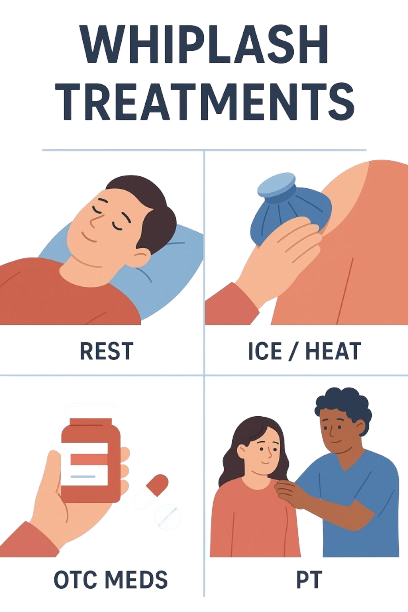
⏱️ How Long Does Whiplash After a Car Accident Last?
Recovery time from whiplash after a car accident can vary from person to person. While many people start to feel better within a few days, others may take several weeks—or even longer—to fully recover.
Typical Recovery Timeline
- Mild cases: 1 to 2 weeks
- Moderate cases: 3 to 6 weeks
- Severe or chronic cases: Several months or more
Most whiplash symptoms go away within a month, especially if you start gentle movement, use hot and cold therapy, and avoid over-resting. But if pain lasts longer than 6 to 8 weeks, or if it starts getting worse instead of better, it’s time to follow up with a doctor or physical therapist.
Factors That Affect Healing
Several things can impact how long your recovery takes:
- The speed and force of the accident
- If you had whiplash or neck problems in the past
- How quickly you began treatment
- Your age and overall health
- Stress or anxiety after the accident
⏱️ Pro tip: Early movement and physical therapy often lead to faster, more complete recovery.
🛠️ Best Products to Support Whiplash Recovery
If you’re recovering from whiplash after a car accident, using the right tools at home can speed up healing and reduce pain. Many of these products are affordable, easy to use, and recommended by physical therapists.
1. Neck Braces (Cervical Collars)

A soft cervical collar can support your neck during the first few days after the injury. It helps limit painful movement and gives your muscles time to rest.
✅ Use it short-term only (no more than 2–3 days), unless your doctor advises otherwise.
Recommended product:
🛒 Soft Foam Neck Brace – Adjustable, Lightweight & Breathable
2. Hot and Cold Packs


Alternate between cold packs (to reduce swelling) and heating pads (to ease muscle tension). Choose reusable options that wrap comfortably around the neck.
Recommended products:
🧊 Reusable Gel Ice Pack for Neck and Shoulders
🔥 Microwaveable Neck Heating Wrap
3. Posture and Support Tools

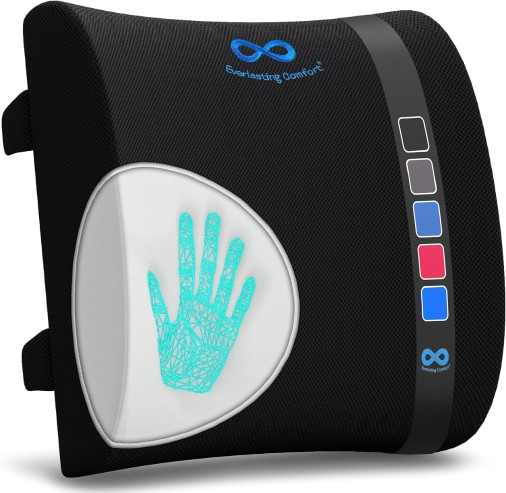
Bad posture can make whiplash worse. Try posture correctors or ergonomic seat cushions to take pressure off your neck—especially if you’re working at a desk.
Recommended products:
💺 Posture Support Brace – Adjustable Back and Shoulder Alignment
🪑 Ergonomic Seat Cushion for Office Chairs and Cars
4. Rehab Tools for Gentle Exercise

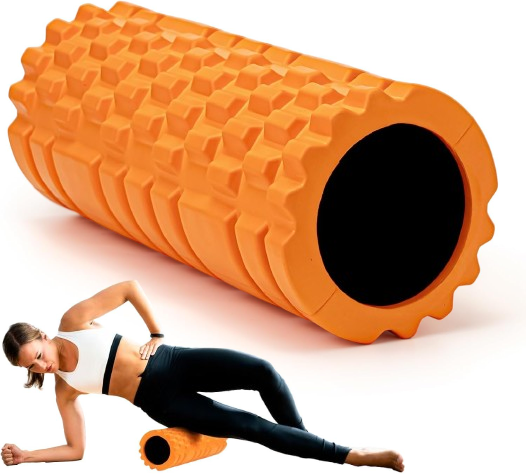
As you begin recovery, light stretching and strengthening help restore neck function. Resistance bands, therapy balls, and foam rollers are great for this stage.
Recommended products:
🏋️ Physical Therapy Resistance Band Kit for Neck and Shoulder Rehab
🧘 Small Foam Roller for Neck and Upper Back Release
5. Pillows for Better Sleep

Sleeping with neck pain can be tough. Using a contoured cervical pillow can support the natural curve of your neck and reduce pain while you rest.
Recommended product:
🛏️ Orthopedic Memory Foam Cervical Pillow – Side & Back Sleeper Friendly
⚠️ What Not to Do If You Have Whiplash After a Car Accident
Recovering from whiplash after a car accident takes more than just rest—it also means avoiding habits that can slow healing or make symptoms worse. Many people accidentally delay recovery by doing the wrong things early on.
Here are some of the most common mistakes to avoid:
1. Don’t Stay in Bed Too Long
It’s okay to rest for the first 24–48 hours, but staying still too long can cause your neck muscles to stiffen and weaken. Gentle movement helps your body heal.
🚫 Avoid: Long hours of lying down, keeping your neck completely still, or skipping light activity.
2. Don’t Ignore the Pain
Neck pain that worsens, spreads, or lasts more than a few days should not be ignored. Delayed treatment can lead to chronic issues or nerve problems.
✅ Do this instead: If pain continues or you feel tingling, numbness, or dizziness, see a healthcare provider.
3. Don’t Skip Neck Exercises
Many people are afraid to move their neck after whiplash—but movement (when done safely) is key to recovery. Skipping rehab can lead to stiffness and slower healing.
📝 Tip: Start with gentle stretches or see a physical therapist for a custom plan.
4. Don’t Use a Neck Brace for Too Long
A neck brace can help in the first few days, but wearing it for too long can weaken your muscles. Unless your doctor advises extended use, limit it to 2–3 days.

5. Don’t Return to Sports or Heavy Lifting Too Soon
Even if you feel a little better, don’t jump back into exercise, sports, or lifting. Your neck needs time to fully recover. Pushing too hard can cause a setback.
🧠 Final Thoughts: Healing From Whiplash After a Car Accident
Whiplash after a car accident can be painful, frustrating, and even a little scary—but with the right care and knowledge, most people recover fully. The key is to listen to your body, start treatment early, and avoid the common mistakes that slow healing.
Don’t ignore the signs. Even if your pain starts days after the crash, it’s still real and treatable. From gentle exercises and posture support to hot/cold therapy and neck pillows, simple steps at home can make a big difference.
If symptoms get worse—or don’t go away after a few weeks—don’t hesitate to see a doctor or physical therapist. The sooner you take action, the sooner you’ll feel better and get back to your normal routine.
🚗 Been in a car accident recently? Take whiplash seriously—and start your recovery the right way.
📢 Before you go! Sign up below for weekly home recovery tips, injury rehab advice, and therapist-approved gear reviews straight to your inbox!!


